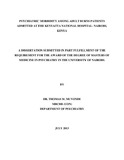| dc.contributor.author | Muvonde, Thomas M | |
| dc.date.accessioned | 2013-10-28T06:49:03Z | |
| dc.date.available | 2013-10-28T06:49:03Z | |
| dc.date.issued | 2013-07 | |
| dc.identifier.citation | Degree Of Masters Of Medicine In Psychiatry, University Of Nairobi, 2013 | en |
| dc.identifier.uri | http://erepository.uonbi.ac.ke:8080/xmlui/handle/11295/57938 | |
| dc.description.abstract | INTRODUCTION: The number of people who have suffered burn injury is increasing
worldwide. The situation is worse in developing countries and locally it is widespread and sporadic in urban areas. Studies conducted worldwide pertaining psychiatric morbidity in burns patients have shown significant psychiatric morbidity.
Many studies have been done globally pertaining psychiatric morbidity among burns patients yet no study of this kind has been done in Kenya in burns patients. This study was an attempt to gather local data and recommend appropriate interventions.
OBJECTIVE: To establish psychiatric morbidity among adult burns patients admitted at KNH Nairobi, Kenya.
SETTING: The study was carried out in the Burns unit and ward 4D- KNH, Nairobi.
METHOD: The study was a cross-sectional descriptive study. The study instruments were Mini International Neuropsychiatric Interview (M.I.N.I) and a researcher designed social demographic and clinical questionnaire. Both of these were administered on 80 adult burn patients drawn from both the Burns unit and ward 4D, KNH selected by purposive sampling.
DATA ANALYSIS: There was double data entry followed by cleaning and analysis using SPSS version 17 and inferential analysis. Chi-square tests were used to analyze the categorical data.
Student’s t-test was used for the continuous variables. The results are summarized in tables, charts, graphs and narratives. The level of significance was set at 0.05.
RESULTS
Out of the 80 patients studied, the male to female ratio was 1.9:1. The age range was18-60years, the mean was 31.7 years (SD10). Majority (91.2%) were Christians while the rest were Muslims. The most common cause of burn injuries was fire (naked flame) at 82.5%. Hot fluids, chemicals and electrical causes accounted for the remainder. Most patients (57.5%) had severe and life threatening burns (>20% TBSA).
Half of the admitted patients had sustained 2nd degree burns and 33.3% had 3rd degree burns. 12.9% had mixed depth of burns.77.5% reported no psychological problems before sustaining burns. 15% had epilepsy while 7.5% reported psychological problems pre burn.
The overall prevalence of psychiatric morbidity among adult burns patients admitted in KNH was 81.3%. 65% of the patients had post traumatic stress disorder, 26.3% had current suicidal risk, major depressive disorder (17.5%) and psychotic disorders (15%).
Marital status showed a significant association with PTSD, with married individuals suffering more PTSD than single and separated individuals.
Age (p=0.04) was significantly associated with suicide risk with younger age groups(18-29 years) having a 39.5% suicide risk compared with 13.8% chance in those between30-39 years.
Younger burns patients also tended to develop depressive symptoms compared to older ones (p=0.006).
Gender was also significantly associated with development of psychotic symptoms (p=0.01) with males being more likely (35.7%) to develop psychotic symptoms than females (11.5%) post burn.
There was also significant association between occurrence of any psychiatric morbidity and the total burn surface area (p=0.036) with the presence of psychiatric morbidity being 89.1% in patients with severe burns (TBSA>20%) compared to 70.6% in patients with TBSA between 5- 20%.
Depth of burns was also significantly associated with development of psychiatric morbidity (p=0.031) with 1st and 2nd degree burns having 92.5% chance of developing psychiatric morbidity compared with 67.9% of 3rd and 4th degree burns and 75% of those with varying burn depths.
CONCLUSION
This study provides important information on the prevalence of psychiatric morbidity among adult burns patients admitted at the country’s main referral hospital. Consisted with other studies, it confirms that psychiatric morbidity is indeed higher in burns patients that in general populations. | en |
| dc.language.iso | en | en |
| dc.publisher | University of Nairobi | en |
| dc.title | Psychiatric Morbidity Among Adult Burns Patients Admitted At The Kenyatta National Hospital- Nairobi, Kenya | en |
| dc.type | Thesis | en |
| dc.description.department | a
Department of Psychiatry, University of Nairobi, ; bDepartment of Mental Health, School of Medicine,
Moi University, Eldoret, Kenya | |
| local.publisher | Department Of Psychiatry | en |

